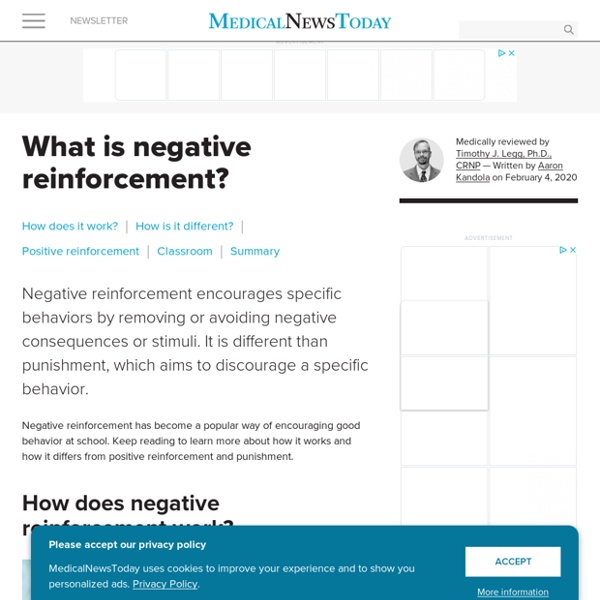



https://www.medicalnewstoday.com/articles/negative-reinforcement
Related: The Power of Reinforcement and Punishment in Shaping Teenagers' Future • A Guide for Parents: Reinforcement & Punishment in Teenagers • parminder_kaurExamples of Positive Reinforcement Whether you deal with young children at home or in the classroom, or you want to be a better manager of adults in the workplace, educational psychologists have studied ways to influence people to get the results you want. One effective way to motivate learners and coworkers is through positive reinforcement: encouraging a certain behavior through a system of praise and rewards. What Is Positive Reinforcement? One important type of learning is called operant conditioning, and it relies on a system of rewards and punishments to influence behavior. The most basic example of operant conditioning is training a dog, whether to do tricks or to stop an unwanted behavior like chewing on furniture.
Negative Reinforcement: What Is It and How Does It Work? What is negative reinforcement? Negative reinforcement is a method that can be used to help teach specific behaviors. With negative reinforcement, something uncomfortable or otherwise unpleasant is taken away in response to a stimulus. Over time, the target behavior should increase with the expectation that the unpleasant thing will be taken away. Read on to learn more about this type of learning. How Positive Reinforcement Improves Student Behavior Children with learning disabilities are prone to behavior problems requiring the use of positive reinforcement.1 Having a learning disability can make a child worry that he is different from his peers, which can lead him to act out in the classroom, at home or both. Some special needs students intentionally engage in bad behavior to avoid facing the classwork that they dread. They may lack the confidence to believe they can manage their learning disabilities.
Punishments, Time Outs, and Rewards: Why Conditional Parenting Doesn't Work (And What Does) - Raised Good The science is in. It’s consistent and compelling. If we want to raise kind, compassionate and cooperative children, there is simply no place for traditional discipline techniques. No time outs. What Is Reinforcement in Operant Conditioning? One of the many different ways in which people can learn is through a process known as operant conditioning (also known as instrumental conditioning).1 This involves learning through reinforcement or punishment. The type of reinforcement used can play an important role in how quickly a behavior is learned and the overall strength of the resulting response. Understanding Reinforcement Reinforcement is a term used in operant conditioning to refer to anything that increases the likelihood that a response will occur. Psychologist B.F.
How to Reward Your Teen for Good Behavior Teenagers are young adults who are trying to learn the ways of the world. When they do something great at school or at home or simply make a healthy decision, parents can give them a reward. The reward does not have to be money, but it is a nice way to say "thank you" or "I'm proud of you." Teens need this positive reinforcement because it shows them that they are on the right track.1 It is also a good life lesson that you can pass on: good things happen to good people. When Do Teenagers Deserve a Reward? The Growing Child- Teenager (13 to 18 Years) How much will my teen grow? The teenage years are also called adolescence. This is a time for growth spurts and puberty changes (sexual maturation).
Effective Communication With Your Teen - Focus on the Family Good communication with teens is vital during conflict. When we asked 5,000 adults what they wished their parents had done differently during times of conflict, they gave these three responses most often: They wished their parents had listened more.They wished they could have talked about feelings more.They wished they had talked to their parents more.